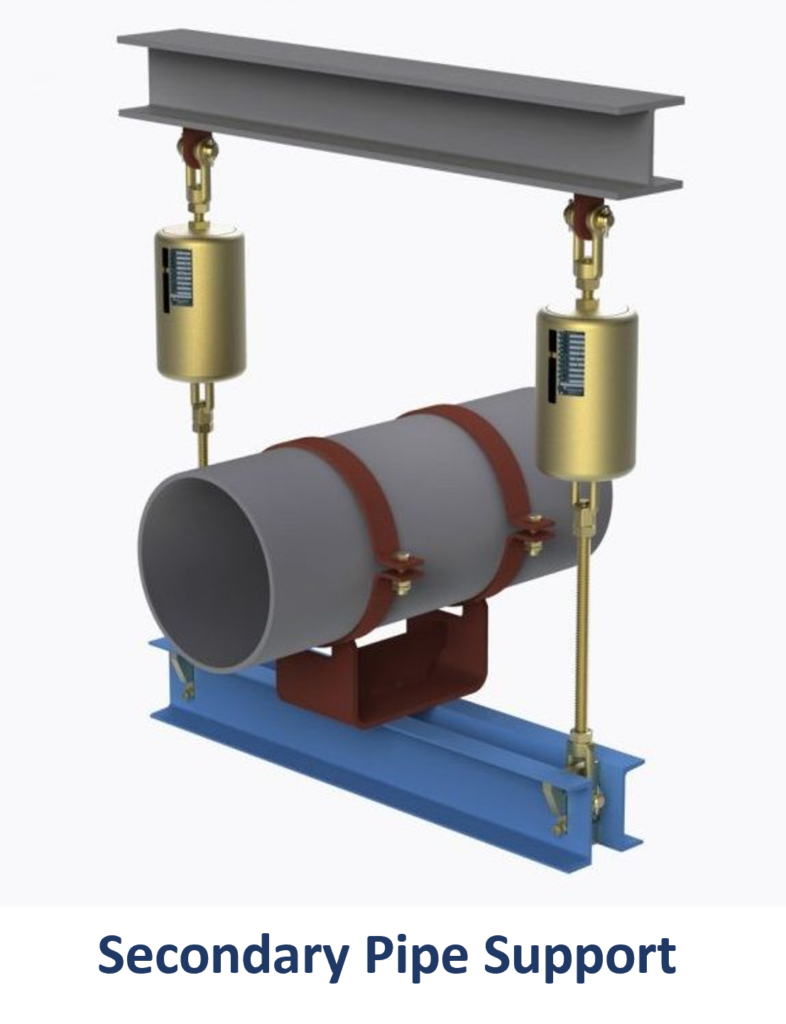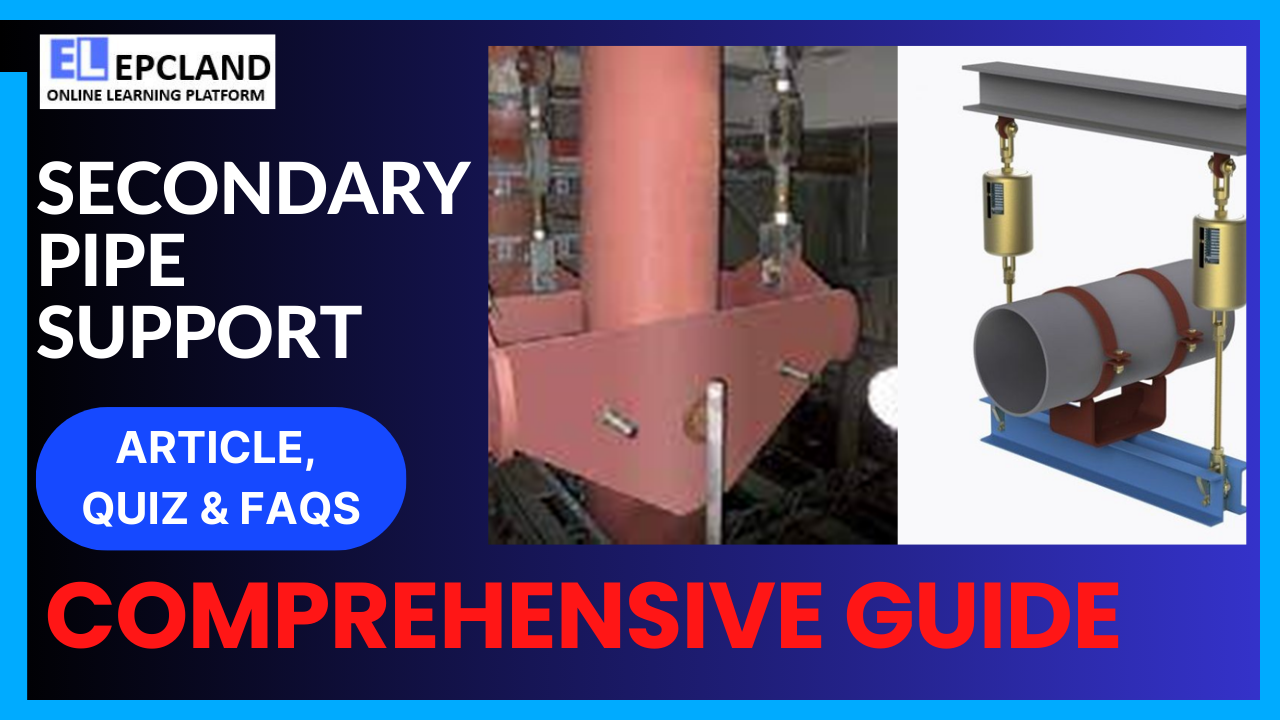Introduction
In the vast and complex world of the oil and gas industry, every component of a project plays a crucial role in ensuring safe and efficient operations. Among these components, secondary pipe supports might not always be in the limelight, but they are an indispensable part of the infrastructure. This article delves into the significance, types, applications, and advantages of secondary pipe supports in the oil and gas sector.
Table of Contents
Don’t miss the Complete Course on Piping Engineering: Check Now
Enrollment Link
Brief History
The Evolution of Secondary Pipe Supports
Secondary pipe supports, also known as pipe hangers or pipe clamps, have a rich history that dates back to the early days of the oil and gas industry. In the 19th century, as pipelines began to crisscross the landscape, the need for reliable and sturdy support for pipes became evident. Early designs were rudimentary, but over the years, advancements in materials and engineering have led to the development of highly specialized secondary pipe support systems.
Basic Function and Working Principle
Secondary pipe supports serve a crucial function in the oil and gas industry by providing the necessary support and restraint to ensure the stability, safety, and longevity of pipelines and associated components. Their primary functions include:
1. Preventing Pipe Sagging
One of the fundamental functions of secondary pipe supports is to prevent pipe sagging or deformation. Pipes carrying liquids or gases can be heavy, and over time, they may experience sagging or bending due to their weight. Secondary pipe supports counteract this gravitational force, ensuring that pipes maintain their intended alignment.
2. Minimizing Vibrations
In dynamic environments such as those found in the oil and gas industry, pipelines can experience vibrations caused by factors like fluid flow, machinery operation, or external forces. Secondary pipe supports dampen these vibrations, preventing excessive movement that could lead to damage or fatigue of the pipeline and its connections.
3. Supporting Thermal Expansion and Contraction
Pipelines are subject to temperature fluctuations, which cause them to expand and contract. Secondary pipe supports are designed to accommodate these thermal movements without imposing excessive stress on the pipes. They allow controlled expansion and contraction to maintain the integrity of the system.
4. Ensuring Safety
Perhaps the most critical function of secondary pipe supports is ensuring the safety of the overall system. By preventing pipe movement, sagging, and vibrations, they help prevent leaks, ruptures, or other failures that could have catastrophic consequences in the oil and gas industry.

Working Principle of Secondary Pipe Supports
The working principle of secondary pipe supports is rooted in the principles of physics and engineering. These supports are carefully designed and strategically placed along the length of pipelines to achieve their objectives. Here’s a more detailed explanation of their working principle:
1. Load Distribution
Secondary pipe supports distribute the weight of the pipe and the fluid or gas it carries evenly to the supporting structure. They do this by transferring the load to the surrounding building or support system, which is often composed of steel or concrete.
2. Attachment and Restraint
Secondary pipe supports consist of various components, including hangers, clamps, and anchors. These components attach to the pipe and are securely anchored to the surrounding structure. This attachment serves two purposes:
- Vertical Support: In the case of pipe hangers, they provide vertical support, suspending the pipe from overhead structures. This prevents the pipe from sagging.
- Lateral Support: Pipe clamps provide lateral support by encircling the pipe and anchoring it to a surface, ensuring that the pipe remains stable horizontally.
3. Flexibility and Movement
Secondary pipe supports are designed with a degree of flexibility to accommodate the dynamic nature of pipelines. Some supports, like spring hangers, incorporate spring mechanisms that allow for vertical movement. This movement is crucial in accommodating thermal expansion and contraction without causing undue stress on the pipes or the support system.
4. Material Selection
The materials used in secondary pipe supports are carefully chosen to withstand the specific conditions of the oil and gas industry, including exposure to corrosive substances and extreme temperatures. Common materials include stainless steel, carbon steel, and specialized coatings to enhance durability and corrosion resistance.
5. Engineering Precision
Design and engineering are critical aspects of secondary pipe support systems. Engineers consider factors such as pipe diameter, weight, temperature variations, fluid properties, and environmental conditions when designing and selecting the appropriate supports. Precise calculations ensure that the supports are positioned correctly to maintain the required alignment and stability of the pipeline.
In essence, secondary pipe supports function by distributing loads, providing attachment and restraint, allowing controlled movement, and employing materials and engineering principles to ensure the safety and reliability of pipelines in the oil and gas industry. Their successful operation is vital for the integrity of the entire infrastructure, from extraction and transportation to processing and distribution.
Don’t miss the Complete Course on Piping Engineering: Check Now
Enrollment Link
Types of Secondary Pipe Supports
1. Pipe Hangers
Design: Pipe hangers consist of a metal or plastic strap that wraps around the pipe, suspending it from overhead structures.
Function: They offer vertical support to pipes, preventing them from sagging or moving downward.
Applications: Pipe hangers are commonly used in scenarios where pipes need to be suspended from ceilings, beams, or other overhead structures. They are effective in maintaining the alignment and elevation of pipes.
Advantages:
- Simple and cost-effective solution for vertical support.
- Easy to install and adjust.
- Suitable for a wide range of pipe sizes and materials.
Disadvantages:
- Limited to providing vertical support and may not prevent lateral movement.
2. Pipe Clamps
Design: Pipe clamps encircle the pipe and are anchored to a surface, providing both vertical and lateral support.
Function: They prevent pipes from moving both vertically and horizontally, ensuring stability.
Applications: Pipe clamps are used when pipes need to be secured to walls, floors, or other surfaces, and when preventing both vertical and lateral movement is essential.
Advantages:
- Offer comprehensive support in both vertical and lateral directions.
- Suitable for use in various pipe configurations and orientations.
- Highly reliable for securing pipes in place.
Disadvantages:
- May require more effort and time to install compared to simple hangers.
3. Spring Hangers
Design: Spring hangers incorporate a spring mechanism that allows for vertical movement of the pipe.
Function: They accommodate thermal expansion and contraction of pipes by allowing controlled vertical movement.
Applications: Spring hangers are used when pipes are subjected to temperature variations, which can cause them to expand or contract. These supports help maintain the correct elevation of the pipe while absorbing thermal movement.
Advantages:
- Effectively absorb vertical movement due to temperature changes.
- Prevents stress and strain on the piping system.
- Can be adjusted to meet specific load and movement requirements.
Disadvantages:
- More complex design and installation compared to static hangers.
4. Slide Plates
Design: Slide plates are typically composed of low-friction materials, such as PTFE or graphite, that allow pipes to move horizontally.
Function: They reduce friction and wear by facilitating controlled horizontal movement of pipes due to thermal expansion or contraction.
Applications: Slide plates are used in situations where pipes need to shift horizontally, such as in long pipeline sections or when connections are exposed to temperature changes.
Advantages:
- Prevents excessive stress on pipes during temperature-induced movement.
- Reduces the risk of pipe buckling or damage.
- Low maintenance requirements.
Disadvantages:
- Limited to addressing horizontal movement and does not provide vertical support.
5. Constant Supports
Design: Constant supports provide a consistent level of support regardless of the pipe’s vertical movement.
Function: They ensure a stable and unchanging support point for pipes, regardless of thermal expansion or contraction.
Applications: Constant supports are used when maintaining a precise elevation of the pipe is critical, and vertical movement needs to be restricted.
Advantages:
- Maintains a constant elevation, which is crucial in specific applications.
- Provides reliable support without the need for adjustment.
- Suitable for situations where vertical movement is not desired.
Disadvantages:
- May not be suitable for scenarios where thermal expansion or contraction is significant.
Each type of secondary pipe support serves a specific purpose in the oil and gas industry, and the choice of support depends on the unique requirements of a given project. By selecting the right type of support, engineers and operators can ensure the integrity, stability, and safety of pipelines in various applications within the industry.
Application of Secondary Pipe Supports
Where and How They Are Used
Secondary pipe supports play a critical role in various stages of oil and gas projects, ensuring the integrity, safety, and efficiency of pipeline systems. Their applications can be categorized into the following key areas:
1. Upstream Operations
In the upstream sector of the oil and gas industry, secondary pipe supports are essential for maintaining the reliability of pipelines that transport crude oil, natural gas, and other hydrocarbons from extraction sites to processing facilities. Here’s how they are applied in upstream operations:
a. Wellhead and Gathering Systems
Secondary pipe supports are used near wellheads and gathering systems to support and secure pipes that carry crude oil and natural gas from individual wells to central processing facilities. These supports prevent sagging and maintain the required elevation for efficient flow.
b. Offshore Platforms
Offshore drilling platforms rely heavily on secondary pipe supports to secure pipes that transport extracted hydrocarbons to the surface. In the harsh marine environment, these supports must withstand dynamic forces, including wave motion and platform movement.
c. Pipeline Transportation
Secondary pipe supports are employed in long-distance pipelines that transport crude oil and natural gas over land and underwater. They ensure that the pipelines remain stable and can withstand external environmental forces, such as ground settlement or seismic activity.
2. Midstream Transportation
The midstream sector of the oil and gas industry involves the transportation of hydrocarbons from production facilities to refineries, storage facilities, and distribution points. Secondary pipe supports play a crucial role in midstream operations in the following ways:
a. Pipeline Infrastructure
Midstream pipelines can span hundreds or even thousands of miles, traversing various terrains and climates. Secondary pipe supports are strategically placed to maintain pipeline stability, reducing the risk of leaks or damage during transportation.
b. Compressor Stations
Compressor stations along the pipeline route require secondary pipe supports to ensure that pipes remain securely in place, even in high-pressure environments. These supports help control vibrations and maintain the structural integrity of the piping system.
c. River Crossings and Bridges
Pipelines often cross rivers and bridges, where support structures are necessary to account for changes in elevation and potential movement. Secondary pipe supports are vital in these situations to prevent damage to the pipes and ensure safety.
3. Downstream Processing
Downstream operations involve the refining and processing of crude oil and natural gas into various products, such as gasoline, diesel, and petrochemicals. Secondary pipe supports are extensively used in downstream processing facilities:
a. Refineries
Refineries are complex facilities with intricate piping systems that transport a variety of fluids and gases. Secondary pipe supports are employed throughout refineries to prevent sagging, vibrations, and other forms of movement that could disrupt production processes.
b. Petrochemical Plants
In petrochemical plants, secondary pipe supports play a crucial role in ensuring the safe and efficient transfer of chemicals and gases. These supports help maintain precise alignment and prevent stresses on pipes, which is essential for the integrity of the entire system.
c. Chemical Processing
Secondary pipe supports are used in various chemical processing applications within the downstream sector. They contribute to the stability of pipelines carrying different chemicals, ensuring safety and preventing costly leaks.
4. Power Generation
Secondary pipe supports are also applied in power generation facilities, particularly in combined cycle power plants where natural gas is a primary fuel source. These supports secure the piping systems that transport natural gas to combustion turbines, helping to maintain efficient power production.
5. Renewable Energy
In the emerging field of renewable energy, secondary pipe supports are used in biomass facilities, biogas plants, and other renewable energy projects where gases or fluids are transported through pipelines. These supports contribute to the reliable operation of these sustainable energy systems.
Don’t miss the Complete Course on Piping Engineering: Check Now
Enrollment Link
Advantages & Disadvantages
Weighing the Pros and Cons
Like any component in the oil and gas industry, secondary pipe supports come with their own set of advantages and disadvantages. Here’s a table summarizing these factors:
| Advantages | Disadvantages |
|---|---|
| 1. Prevent pipe sagging | 1. Initial installation cost |
| 2. Ensure pipeline safety | 2. Regular maintenance required |
| 3. Accommodate thermal expansion | 3. Potential for corrosion |
| 4. Support long pipelines |
Associated Codes & Standards
Ensuring Compliance and Safety
The oil and gas industry is highly regulated to ensure the safety and reliability of operations. When it comes to secondary pipe supports, adherence to industry-specific codes and standards is crucial. Some of the key codes and standards relevant to secondary pipe supports include:
1. ASME B31.1 and ASME B31.3
The American Society of Mechanical Engineers (ASME) codes B31.1 and B31.3 provide guidelines for power piping and process piping, respectively. These codes outline requirements for the design, installation, inspection, and maintenance of secondary pipe supports.
2. MSS SP-58 and MSS SP-69
The Manufacturers Standardization Society of the Valve and Fittings Industry (MSS) standards SP-58 and SP-69 specifically address the design and installation of pipe hangers and supports. Compliance with these standards ensures the proper functioning and safety of secondary pipe supports.
3. API RP 686
The American Petroleum Institute’s (API) Recommended Practice 686 provides guidelines for the evaluation and design of pipe support systems. It offers valuable insights into ensuring the reliability of secondary pipe supports in the oil and gas industry.
Conclusion
Secondary pipe supports may not always be in the spotlight, but their role in the oil and gas industry is indispensable. These unassuming components ensure the stability and safety of pipelines that crisscross the globe, delivering the energy resources that power our world. Understanding their significance, types, applications, and adherence to industry standards is essential for the successful execution of oil and gas projects. As the industry continues to evolve, secondary pipe supports will remain a vital part of the infrastructure that drives progress and innovation in the energy sector.
In conclusion, secondary pipe supports may not be the stars of the show, but they are the unsung heroes that keep the industry running smoothly and safely.
FAQs
1. What is the primary purpose of secondary pipe supports in the oil and gas industry?
Secondary pipe supports play a crucial role in the industry by providing support and restraint to pipelines. Their primary purpose is to prevent sagging, vibrations, and excessive movement of pipes, ensuring the integrity and safety of the pipeline system.
2. Are there different types of secondary pipe supports, and how do they differ in functionality?
Yes, there are various types of secondary pipe supports, including pipe hangers, pipe clamps, spring hangers, slide plates, and constant supports. These differ in functionality; for example, pipe hangers provide vertical support, while pipe clamps offer both vertical and lateral support. The choice of support type depends on specific project requirements.
3. Where are secondary pipe supports typically used in the oil and gas industry projects?
Secondary pipe supports find applications in all stages of oil and gas projects. They are used in upstream operations to support pipelines transporting crude oil or gas, in midstream transportation to secure long-distance pipelines, and in downstream processing facilities to maintain stability in complex piping systems.
4. What are some advantages of using secondary pipe supports, and are there any drawbacks?
Advantages of secondary pipe supports include preventing pipe sagging, ensuring pipeline safety, accommodating thermal expansion, and supporting long pipelines. However, they may require an initial installation cost, regular maintenance, and may be susceptible to corrosion over time.
5. How can one ensure compliance with industry standards when using secondary pipe supports?
Ensuring compliance with industry standards is essential for safety and reliability. To achieve this, it’s crucial to adhere to codes and standards such as ASME B31.1, ASME B31.3, MSS SP-58, MSS SP-69, and API RP 686. These standards provide guidelines for the design, installation, inspection, and maintenance of secondary pipe supports, helping maintain their proper functioning and safety in the oil and gas industry.
Recommended courses (Published on EPCLand)
- Basics of Piping Engineering
- Piping Layout Engineering
- Piping Material Engineering
- Piping Stress Analysis
- Complete Course on Piping Engineering
- Material Requisitions
- Piping Material Specifications
- Valve Material Specifications
Don’t miss the published articles on following:
Don’t miss the Complete Course on Piping Engineering: Check Now
Enrollment Link
Attempt Quiz
Question 1:
What is the primary purpose of secondary pipe supports in an oil & gas project?
Explanation: Secondary pipe supports provide additional structural support to piping systems in oil & gas projects.
Question 2:
Which of the following materials is commonly used for secondary pipe supports in the oil & gas industry?
Explanation: Steel is commonly used for secondary pipe supports in the oil & gas industry due to its strength and durability.
Question 3:
What is the main function of secondary pipe supports in preventing vibration?
Explanation: Secondary pipe supports are designed to dampen or absorb vibration, reducing the impact on the piping system.
Question 4:
What is the primary advantage of using secondary pipe supports in an oil & gas project?
Explanation: The primary advantage of using secondary pipe supports is increased stability and safety in the piping system of an oil & gas project.
Question 5:
Which industry standard is commonly followed in the installation of secondary pipe supports in oil & gas projects?
Explanation: ASME B31.3 is a commonly followed industry standard for the installation of secondary pipe supports in oil & gas projects.
Question 6:
What is the purpose of thermal insulation in secondary pipe supports?
Explanation: Thermal insulation in secondary pipe supports helps prevent heat loss or gain in the piping system.
Question 7:
What is the typical lifespan of secondary pipe supports in an oil & gas project?
Explanation: The typical lifespan of secondary pipe supports in an oil & gas project can range from 15 to 20 years when properly maintained.
Question 8:
What is the primary function of shock absorbers in secondary pipe supports?
Explanation: Shock absorbers in secondary pipe supports are designed to dampen sudden movements and vibrations, ensuring the stability of the piping system.
Question 9:
What type of loads are secondary pipe supports designed to withstand?
Explanation: Secondary pipe supports are designed to withstand both static and dynamic loads in an oil & gas project.
Question 10:
What is the primary role of secondary pipe supports in pipeline routing?
Explanation: The primary role of secondary pipe supports in pipeline routing is to maintain proper pipe alignment and elevation.



